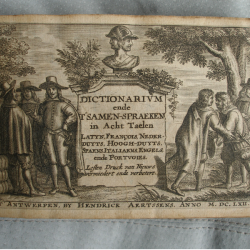
Winter 2018, Bibliographic Notes and Queries, Query 528: An Engraved Title-Page for Noel van Barlement, Dictionariolum et colloquia, 1662.
A recent article on Noel Van Barlement and his Colloquia et dictionariolum carried an illustration of the engraved title-page to the 1632 Amsterdam edition, one of two such editions.1 The other engraved title is found to the 1662 edition published in Antwerp by Hendrik Aertssens. This engraving is much more elaborate with a considerable amount of intricate detail much of which has symbolic signification; some overt, some not so obvious to twenty-first-century eyes. There is also a puzzle that some readers might be able to unravel.
The engraving is an added title-page in Dutch to this eight-language edition which also has the normal Latin title on the following leaf [A2] recto.2 The engraving, signed ‘Lommelin sculp’, shows eight men, in two groups of four, conversing under some trees, either side of a monument which carries the title.3 The monument is surmounted by a Janus head. The outer layer of symbolism is uncomplicated. The eight men represent the eight languages offered, coupled with Janus signifying a gateway. This idea of language books constituting a gateway to the learning of a language or languages had already been adopted, first by William Bathe in his Ianua linguarum (‘The Gate of Tongues’), and a few years later J.A. Comenius, in a not wholly respectful homage, tweaked the same title for his similar work Janua linguarum reserata (‘The Gate of Tongues Unlocked’).4
The Preface to the Dictionariolum et colloquia lists the publishers’ target group of readers/purchasers: merchants, those with business at court, soldiers, and the general traveler. It goes on to specify what benefit the reader will gain from the book: the ability to converse directly with people of other nations without the need of an interpreter will encourage friendship between peoples, thus assisting commerce and thereby the acquisition of wealth, and help the governance of foreign lands and cities. The contents underline these aims, the dialogues are largely angled towards markets and trading as are the form business letters, but also offer something for all travelers in general.
A closer look at the engraving shows these aims clearly revealed in the finer detail. Unusually Janus has two distinct faces. Facing right, with winged hat, is Mercury, protector of merchants, marketplaces, and travelers. Facing left, older, bearded and with rudimentary armor, is Mars – in this case apparently in his less familiar office, ‘Mars Pacifier’, for facing him is an olive branch, his attribute when in this role. The idea of Mars as a pacific influence makes sense today in that to be well armed and prepared is a good way to deter potential aggressors. In addition, Mars is not just a bringer of peace, he is a peacemaker because he subdues his enemies. The symbolism of Mercury’s ivy is less clear. In this case it seems that it is probably that of love (clinging) and thus friendship.
The eight men are divided into two groups: those on the left are merchants, with behind and to the left of them symbols of their occupation, a barrel and a bale of wool. They are depicted presumably doing business in what is clearly a friendly spirit. They are under the direct influence of Mars Pacifier and the hostile military battle is replaced by the benign ‘battle’ of haggling and trade. The right-hand group are themselves split into two. The couple to the front, to whom we are directed by the trailing stem of ivy, are greeting each other in friendship; hats removed in the traditional gesture of salutation, and with one clasping the elbow of the other. This strengthens the case for interpreting the ivy as representing friendship. Here Mercury, the divine embodiment of travel and trade, is generating friendship across linguistic boundaries. These same two are more grandly dressed and could be imagined as being of some eminence and having business in government and at court. The role, if any, of the other two figures on the right is not clear. They may just be travelers. The one in the long cloak is distinctively dressed and there may well be other hidden messages in this picture.
There is, however, one real puzzle. The bale of wool beside the merchants is clearly marked 4/EQ, which undoubtedly must have some significance in the context of this engraving. So far research has not yielded any answer. I would be delighted if someone could come up with an explanation.
Endnotes:
1. Nigel Stoughton, ‘The First Foreign Phrasebook’, THE BOOK COLLECTOR (vol. 64, Autumn 2015).
2. In this edition the normal order of the title has been reversed: Dictionariolum et colloquia octo linguarum . . . rather than the usual Colloquia et dictionariolum . . .
The whole title is repeated in contrasting and smaller type underneath in French. However, the Dutch title that would normally be found beneath that is carried by the engraving on the preceding leaf. This special and unique treatment implies that this edition was designed for the Dutch home market.
3. Adriaen Lommelin (1640–1680). Born in Amiens, Lommelin travelled to Flanders in 1654 and studied engraving techniques under Joseph Cossie in Antwerp. In 1662 he was admitted as a master in the Antwerp Guild.
4. William Bathe, Ianua linguarum . . . (Salamanca, 1611); Johann Amos Comenius or Komensky, Janua linguarum reserata . . . (Leszno, 1631).
Click on the image below to view in full size.
